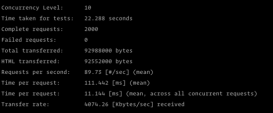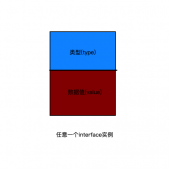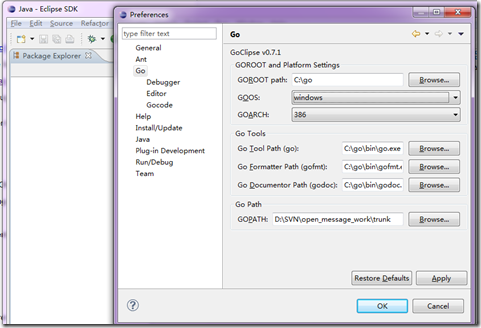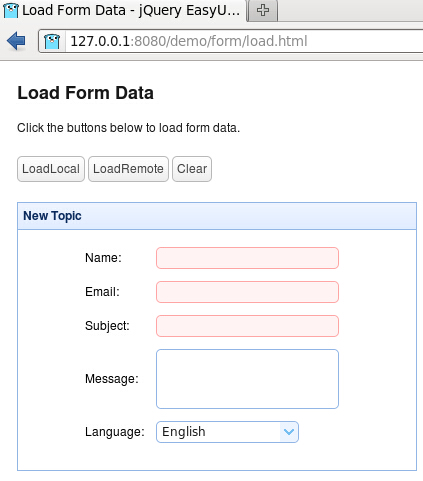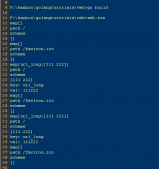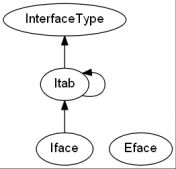Go语言里的集合一般会用map[T]bool这种形式来表示,T代表元素类型。集合用map类型来表示虽然非常灵活,但我们可以以一种更好的形式来表示它。
例如在数据流分析领域,集合元素通常是一个非负整数,集合会包含很多元素,并且集合会经常进行并集、交集操作,这种情况下,bit数组会比map表现更加理想。
一个bit数组通常会用一个无符号数或者称之为“字”的slice来表示,每一个元素的每一位都表示集合里的一个值。当集合的第i位被设置时,我们才说这个集合包含元素i。
下面的这个程序展示了一个简单的bit数组类型,并且实现了三个函数来对这个bit数组来进行操作:
|
1
2
3
4
5
6
7
8
9
10
11
12
13
14
15
16
17
18
19
20
21
22
23
24
25
26
27
28
29
30
31
32
33
34
35
36
37
|
package mainimport ( "bytes" "fmt")// An IntSet is a set of small non-negative integers.// Its zero value represents the empty set.type IntSet struct { words []uint}const ( bitNum = (32 << (^uint(0) >> 63)) //根据平台自动判断决定是32还是64)// Has reports whether the set contains the non-negative value x.func (s *IntSet) Has(x int) bool { word, bit := x/bitNum, uint(x%bitNum) return word < len(s.words) && s.words[word]&(1<<bit) != 0}// Add adds the non-negative value x to the set.func (s *IntSet) Add(x int) { word, bit := x/bitNum, uint(x%bitNum) for word >= len(s.words) { s.words = append(s.words, 0) } s.words[word] |= 1 << bit}//A与B的交集,合并A与B// UnionWith sets s to the union of s and t.func (s *IntSet) UnionWith(t *IntSet) { for i, tword := range t.words { if i < len(s.words) { s.words[i] |= tword } else { s.words = append(s.words, tword) } }} |
因为每一个字都有64个二进制位,所以为了定位x的bit位,我们用了x/64的商作为字的下标,并且用x%64得到的值作为这个字内的bit的所在位置。
例如,对于数字1,将其加入比特数组:
|
1
2
3
4
5
6
7
8
|
func (s *IntSet) Add(x int) { word, bit := x/bitNum, uint(x%bitNum) //0, 1 := 1/64, uint(1%64) for word >= len(s.words) { // 条件不满足 s.words = append(s.words, 0) } s.words[word] |= 1 << bit // s.words[0] |= 1 << 1}// 把1存入后,words数组变为了[]uint64{2} |
同理,假如我们再将66加入比特数组:
|
1
2
3
4
5
6
7
8
|
func (s *IntSet) Add(x int) { word, bit := x/bitNum, uint(x%bitNum) //1, 2 := 66/64, uint(66%64) for word >= len(s.words) { // 条件满足 s.words = append(s.words, 0) // 此时s.words = []uint64{2, 0} } s.words[word] |= 1 << bit // s.words[1] |= 1 << 2}// 继续把66存入后,words数组变为了[]uint64{2, 4} |
所以,对于words,每个元素可存储的值有64个,每超过64个则进位,即添加一个元素。(注意,0也占了一位,所以64才要进位,第一个元素可存储0-63)。
所以,对于words中的一个元素,要转换为具体的值时:首先取到其位置i,用 64 * i 作为已进位数(类似于每10位要进位), 然后将这个元素转换为二进制数,从右往左数,第多少位为1则表示相应的有这个值,用这个位数 x+64 *i 即为我们存入的值。
相应的,可有如下String()函数
|
1
2
3
4
5
6
7
8
9
10
11
12
13
14
15
16
17
18
19
20
|
// String returns the set as a string of the form "{1 2 3}".func (s *IntSet) String() string { var buf bytes.Buffer buf.WriteByte('{') for i, word := range s.words { if word == 0 { continue } for j := 0; j < bitNum; j++ { if word&(1<<uint(j)) != 0 { if buf.Len() > len("{") { buf.WriteByte(' ') } fmt.Fprintf(&buf, "%d", bitNum*i+j) } } } buf.WriteByte('}') return buf.String()} |
例如,前面存入了1和66后,转换过程为:
|
1
2
3
4
|
// []uint64{2 4}// 对于2: 1 << 1 = 2; 所以 x = 0 * 64 + 1 // 对于4: 1 << 2 = 4; 所以 x = 1 * 64 + 2// 所以转换为String为{1 66} |
实现比特数组的其他方法函数
|
1
2
3
4
5
6
7
8
9
10
11
12
13
14
15
16
17
18
19
20
21
22
23
24
25
26
27
28
29
30
31
32
33
34
35
36
37
38
39
40
41
42
43
44
45
46
47
48
49
50
51
52
53
54
55
56
57
58
59
60
61
62
63
64
65
66
67
68
69
70
71
72
73
74
75
|
func (s *IntSet) Len() int { var len int for _, word := range s.words { for j := 0; j < bitNum; j++ { if word&(1<<uint(j)) != 0 { len++ } } } return len}func (s *IntSet) Remove(x int) { word, bit := x/bitNum, uint(x%bitNum) if s.Has(x) { s.words[word] ^= 1 << bit }}func (s *IntSet) Clear() { s.words = append([]uint{})}func (s *IntSet) Copy() *IntSet { intSet := &IntSet{ words: []uint{}, } for _, value := range s.words { intSet.words = append(intSet.words, value) } return intSet}func (s *IntSet) AddAll(args ...int) { for _, x := range args { s.Add(x) }}//A与B的并集,A与B中均出现func (s *IntSet) IntersectWith(t *IntSet) { for i, tword := range t.words { if i >= len(s.words) { continue } s.words[i] &= tword }}//A与B的差集,元素出现在A未出现在Bfunc (s *IntSet) DifferenceWith(t *IntSet) { t1 := t.Copy() //为了不改变传参t,拷贝一份 t1.IntersectWith(s) for i, tword := range t1.words { if i < len(s.words) { s.words[i] ^= tword } }}//A与B的并差集,元素出现在A没有出现在B,或出现在B没有出现在Afunc (s *IntSet) SymmetricDifference(t *IntSet) { for i, tword := range t.words { if i < len(s.words) { s.words[i] ^= tword } else { s.words = append(s.words, tword) } }}//获取比特数组中的所有元素的slice集合func (s *IntSet) Elems() []int { var elems []int for i, word := range s.words { for j := 0; j < bitNum; j++ { if word&(1<<uint(j)) != 0 { elems = append(elems, bitNum*i+j) } } } return elems} |
至此,比特数组的常用方法函数都已实现,现在可以来使用它。
|
1
2
3
4
5
6
7
8
9
10
11
12
13
14
15
16
17
18
19
20
21
22
23
24
25
26
27
28
29
30
31
32
33
34
35
36
|
func main() { var x, y IntSet x.Add(1) x.Add(144) x.Add(9) fmt.Println("x:", x.String()) // "{1 9 144}" y.Add(9) y.Add(42) fmt.Println("y:", y.String()) // "{9 42}" x.UnionWith(&y) fmt.Println("x unionWith y:", x.String()) // "{1 9 42 144}" fmt.Println("x has 9,123:", x.Has(9), x.Has(123)) // "true false" fmt.Println("x len:", x.Len()) //4 fmt.Println("y len:", y.Len()) //2 x.Remove(42) fmt.Println("x after Remove 42:", x.String()) //{1 9 144} z := x.Copy() fmt.Println("z copy from x:", z.String()) //{1 9 144} x.Clear() fmt.Println("clear x:", x.String()) //{} x.AddAll(1, 2, 9) fmt.Println("x addAll 1,2,9:", x.String()) //{1 2 9} x.IntersectWith(&y) fmt.Println("x intersectWith y:", x.String()) //{9} x.AddAll(1, 2) fmt.Println("x addAll 1,2:", x.String()) //{1 2 9} x.DifferenceWith(&y) fmt.Println("x differenceWith y:", x.String()) //{1 2} x.AddAll(9, 144) fmt.Println("x addAll 9,144:", x.String()) //{1 2 9 144} x.SymmetricDifference(&y) fmt.Println("x symmetricDifference y:", x.String()) //{1 2 42 144} for _, value := range x.Elems() { fmt.Print(value, " ") //1 2 42 144 }} |
以上为个人经验,希望能给大家一个参考,也希望大家多多支持服务器之家。如有错误或未考虑完全的地方,望不吝赐教。
原文链接:https://blog.csdn.net/qq_34434641/article/details/80418124



